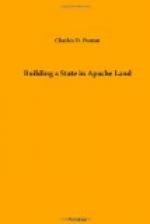As the ores in the Santa Rita Mountains did not make a satisfactory yield, we turned our explorations to the west of the Santa Cruz River, and soon struck a vein of petanque (silver copper glance) that yielded from the grass roots seven thousand dollars a ton. This mine was named in honor of the president of the company, “Heintzelman,” which in German mining lore is also the name of the genius who presides over mines.
The silver bullion over expenses, which were about fifty per cent, was shipped, via Guaymas, to San Francisco, where it brought from 125 to 132 cents per ounce for the Asiatic market.
Silver bars form rather an inconvenient currency, and necessity required some more convenient medium. We therefore adopted the Mexican system of “boletas.” Engravings were made in New York, and paper money printed on pasteboard about two inches by three in small denominations, twelve and one half cents, twenty-five cents, fifty cents, one dollar, five dollars, ten dollars. Each boleta had a picture, by which the illiterate could ascertain its denomination, viz: twelve and a half cents, a pig; twenty-five cents, a calf; fifty cents, a rooster; one dollar, a horse; five dollars, a bull; ten dollars, a lion. With these “boletas” the hands were paid off every Saturday, and they were currency at the stores, and among the merchants of the country and in Mexico. When a run of silver was made, anyone holding tickets could have them redeemed in silver bars, or in exchange on San Francisco. This primitive system of greenbacks worked very well,—everybody holding boletas was interested in the success of the mines; and the whole community was dependent on the prosperity of the company. They were all redeemed. Mines form the bank of Nature, and industry puts the money in circulation, to the benefit of mankind.
In the autumn of 1857 a detachment from the regiment of First Dragoons arrived in the Santa Cruz Valley, for the purpose of establishing a military post, and for the protection of the infant settlements. The officers were Colonel Blake, Major Stein, and Captain Ewell. The first military post was established at Calaveras, and the arrival of the officers made quite an addition to the society on the Santa Cruz.
Incident to the arrival of the military on the Santa Cruz was a citizens’ train of wagons laden with supplies,—twelve wagons of twelve mules each,—belonging to Santiago Hubbell, of New Mexico. While he was encamped at Tubac I inquired the price of freight, and learned it was fifteen cents a pound from Kansas City. I inquired what he would charge to take back a freight of ores, and he agreed to haul them from the Heintzelman mine to Kansas City and a steamboat for twelve and a half cents a pound, and I loaded his wagons with ores in rawhide bags,—a ton to the wagon. This was the first shipment of ores, and a pretty “long haul.”
Upon the arrival of these ores in the States they were distributed to different cities for examination and assay, and gave the country its first reputation as a producer of minerals. The average yield in silver was not enormous, as the ores contained a great deal of copper, but the silver yield was about fifteen hundred dollars to the ton.




